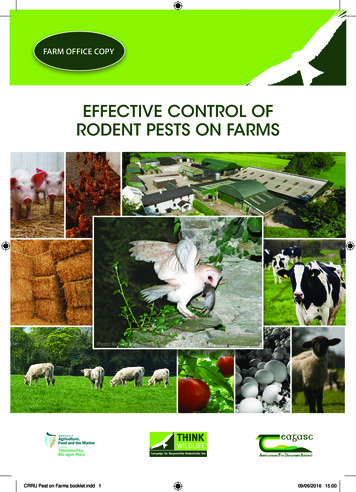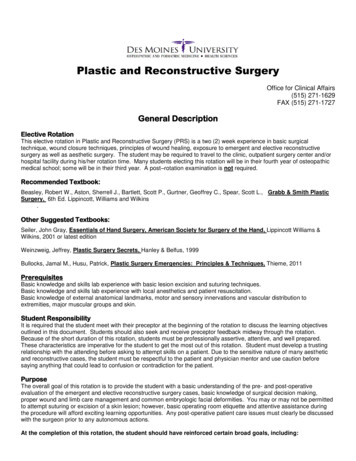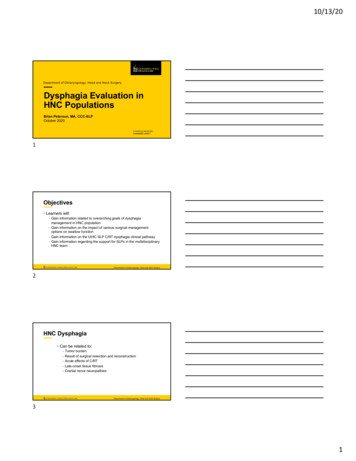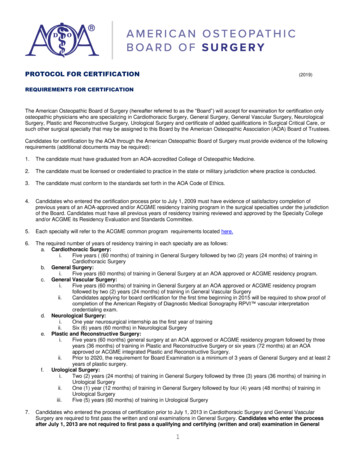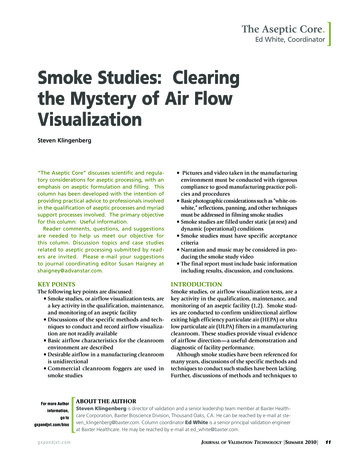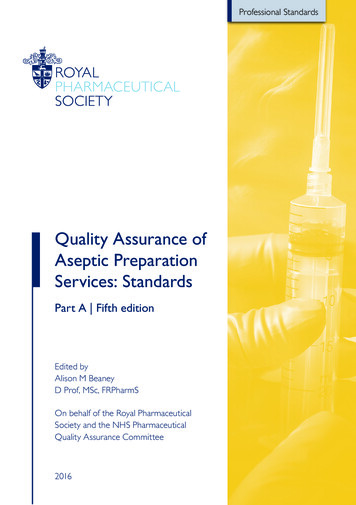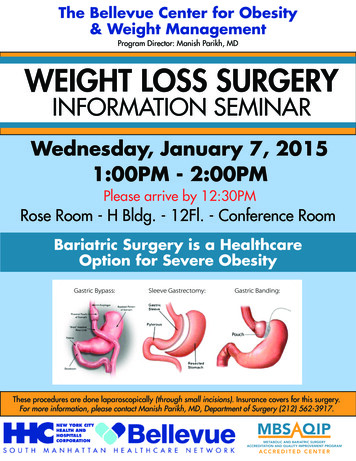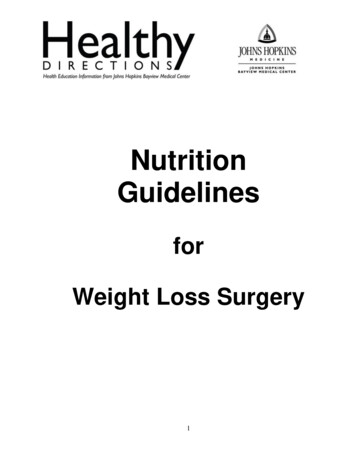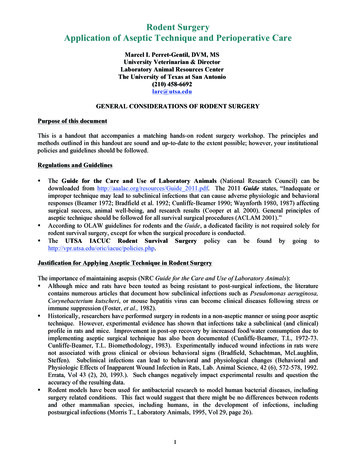
Transcription
Rodent SurgeryApplication of Aseptic Technique and Perioperative CareMarcel I. Perret-Gentil, DVM, MSUniversity Veterinarian & DirectorLaboratory Animal Resources CenterThe University of Texas at San Antonio(210) 458-6692larc@utsa.eduGENERAL CONSIDERATIONS OF RODENT SURGERYPurpose of this documentThis is a handout that accompanies a matching hands-on rodent surgery workshop. The principles andmethods outlined in this handout are sound and up-to-date to the extent possible; however, your institutionalpolicies and guidelines should be followed.Regulations and Guidelines The Guide for the Care and Use of Laboratory Animals (National Research Council) can bedownloaded from http://aaalac.org/resources/Guide 2011.pdf. The 2011 Guide states, “Inadequate orimproper technique may lead to subclinical infections that can cause adverse physiologic and behavioralresponses (Beamer 1972; Bradfield et al. 1992; Cunliffe-Beamer 1990; Waynforth 1980, 1987) affectingsurgical success, animal well-being, and research results (Cooper et al. 2000). General principles ofaseptic technique should be followed for all survival surgical procedures (ACLAM 2001).”According to OLAW guidelines for rodents and the Guide, a dedicated facility is not required solely forrodent survival surgery, except for when the surgical procedure is conducted.The UTSA IACUC Rodent Survival Surgery policy can be found by going ification for Applying Aseptic Technique in Rodent SurgeryThe importance of maintaining asepsis (NRC Guide for the Care and Use of Laboratory Animals): Although mice and rats have been touted as being resistant to post-surgical infections, the literaturecontains numerous articles that document how subclinical infections such as Pseudomonas aeruginosa,Corynebacterium kutscheri, or mouse hepatitis virus can become clinical diseases following stress orimmune suppression (Foster, et al., 1982). Historically, researchers have performed surgery in rodents in a non-aseptic manner or using poor aseptictechnique. However, experimental evidence has shown that infections take a subclinical (and clinical)profile in rats and mice. Improvement in post-op recovery by increased food/water consumption due toimplementing aseptic surgical technique has also been documented (Cunliffe-Beamer, T.L, 1972-73.Cunliffe-Beamer, T.L. Biomethodology, 1983). Experimentally induced wound infections in rats werenot associated with gross clinical or obvious behavioral signs (Bradfield, Schachtman, McLaughlin,Steffen). Subclinical infections can lead to behavioral and physiological changes (Behavioral andPhysiologic Effects of Inapparent Wound Infection in Rats, Lab. Animal Science, 42 (6), 572-578, 1992.Errata, Vol 43 (2), 20, 1993.). Such changes negatively impact experimental results and question theaccuracy of the resulting data. Rodent models have been used for antibacterial research to model human bacterial diseases, includingsurgery related conditions. This fact would suggest that there might be no differences between rodentsand other mammalian species, including humans, in the development of infections, includingpostsurgical infections (Morris T., Laboratory Animals, 1995, Vol 29, page 26).1
The Surgical EnvironmentDefinitions: Sterile: Free from all living microorganisms and their spores. Asepsis: Very insignificant numbers of microorganisms. A condition in which living pathogenicorganisms are absent; a state of sterility. Aseptic surgery: The performance of an operation with sterile gloves, instruments, etc., and utilizingprecautions against the introduction of infectious microorganisms from the outside environment. Contaminated/Colonized: Bacteria/microorganisms present ( 106/gram tissue on average animal).Clinical signs may or may not be present. Immune response may be able to ward off infection. Infected/Sepsis: Bacteria/microorganisms present ( 106/gram tissue on average animal). Clinicalinfection is evident and cultures are positive.0 BacteriaSterile ContaminatedAseptic 1,000,000InfectedSterilization: The process whereby all viable microorganisms are eliminated or destroyed. The criterionfor adequate sterilization is the failure of organisms to grow if a growth-supporting medium is supplied.Disinfection: The chemical or physical process that involves the destruction of pathogenic organisms.All disinfectants are effective against vegetative forms of organisms, but not necessarily spores.Major Survival Surgery (Guide 2011 definition): As a general guideline, major survival surgery (e.g.,laparotomy, thoracotomy, joint replacement, and limb amputation) penetrates and exposes a body cavity,produces substantial impairment of physical or physiologic functions, or involves extensive tissuedissection or transection.Minor Survival Surgery (Guide 2011 definition): Minor survival surgery does not expose a body cavityand causes little or no physical impairment; this category includes wound suturing, peripheral vesselcannulation, percutaneous biopsy, routine agricultural animal procedures such as castration, and mostprocedures routinely done on an “outpatient” basis in veterinary clinical practice. Animals recoveringfrom these minor procedures typically do not show significant signs of postoperative pain, have minimalcomplications, and return to normal function in a relatively short time.Special Considerations Rats and mice have a high surface area to body volume ratio and rapid metabolism. Therefore,o rodents have a high metabolic rate and limited fat storage. Energy depletion can be stressful.o pharmacological doses tend to be higher in rodents than in larger species.o rodents dehydrate faster per unit of time.o rodents lose body heat rapidly. Hypothermia during surgery is a frequent cause of intraoperativemortality or prolonged and stressful recovery.Surgical Stress:o The major responses to surgery are characterized by an elevation in plasma concentrations ofcatecholamines, corticosterone, growth hormone, vasopressin, renin, aldosterone and prolactin, andby a reduction in plasma concentrations of FSH, LH and testosterone. Plasma insulin and glucagonconcentrations fluctuate. These hormonal responses to tissue trauma produce an increase inglycogenolysis and lipolysis, and result in hyperglycemia. The duration of the hyperglycemiavaries, but after major surgery the response may persist for 4-6 hours. More prolonged changes inprotein metabolism occur, leading to negative nitrogen balance lasting for several days. Even minorsurgical procedures can produce prolonged effects.o Minimizing tissue trauma, preventing infection, controlling postsurgical pain and discomfort, andsupporting the animal’s nutritional needs will reduce the magnitude of the metabolic response tosurgery. The purpose of a survival surgical procedure is to produce an animal model that is definedand that has the smallest degree of controllable variables. An important objective is to return theanimal to physiological normality as rapidly as possible. Particular attention to excellent careduring the first 4-6 hours post-op is key to the rodent’s recovery.2
Hemostasis It is important to minimize/control bleeding during surgery because blood loss:o Creates an ideal environment for bacterial growth.o Leads to poor recovery and stress.o Increases the chance of death.o Increases recovery time.o May introduce research variables.To minimize blood loss:o Dissect along tissue planes.o Do not cut across muscle when possible.o Identify, isolate and retract large vessels.o Know the anatomy.o Apply good hemostasis technique (direct pressure, cautery, hemostatic products, ligation, etc.).Tissue Trauma & Contamination Trauma and infection negatively impact the animal and alsoserve as confounding variables for experimental data.Diminish tissue trauma and infection by adhering to thefollowing four principles:1. Surgery is gentle: Rough tissue handling results inincreased pain, infection (clinical & subclinical) andrecovery time.2. Time is trauma: Organ exposure to room environmentis toxic to tissues. The longer the exposure the greaterthe trauma. Find the right balance between speed andfine surgical technique.Incidence of infectionincreases three times when surgery is longer than 90minutes.3. Wet tissues are happy tissues: Avoid desiccation (drying) of exposed tissues by maintaining tissuesmoist at all times with warm saline or lactated ringer’s solution (LRS).4. The solution for pollution is dilution: Infection occurs when the number (generally 106 infectiousparticles/gram [IP/gr] of tissue in immunocompetent animals) of infectious particles overwhelmsthe animal’s immune system. Adhere as close as possible to the aseptic principles outlined in thesenotes to diminish the number of microorganisms in the wound site. If contamination occurs duringthe surgical procedure, dilute the contaminant with use of copious amounts of warm rinse solution(sterile saline or lactated Ringer’s solution).0 BacteriaSterileContaminatedAseptic 1,000,000InfectedDealing with the Risk There is no such thing as a 100% guarantee of “sterility” or a risk-free environment, therefore bringingthe number of infectious particles to low and practical risk levels should be the goal.The level of acceptable risk depends on:o Type and length of procedure.o Complexity of the procedure.o Species, physiological status and immune status.o Surgeon’s training/skills/experience.o Animal preparation.o Surgical instrument/supplies preparation.o Aseptic technique.3
Effects of Biomaterials Introduction of biomaterials into the body significantly decreases the number of infectious particlesneeded to result in infection.When biomaterials (e.g., catheters) are introduced into an animal, the following follows:o 1000-10,000 bacteria/microorganisms present (Paston et al. J Clin Micro, 1993).o Animals may become clinically infected.o Cultures turn positive.0 Bacteria1,00010,000Sterile Aseptic Contaminated Infected 1,000,000Preoperative Preparation of the Animal Assess health status. Recommendations:o Allow a minimum of a 3-day acclimation to the new environment to overcome the stress oftransportation.o Should be free of clinical signs of disease: Appearance should include normal posture and movement, glossy coat, bright eyes. Assess the character of respiration (no unusual respiratory sounds or pattern) and thecardiovascular status (bright pink coloration of ears and mucous membranes). Normal intake of food and water.Fasting rats and mice is generally unnecessary. Because rats and mice do not vomit, they do not have therisk of intra/post-op vomiting as in other species. If you will perform a surgery on the gastrointestinaltract, then you can fast the animals but briefly (a few hours). However, the reason for doing it should beconsidered carefully and weighed against the disturbance of normal metabolic processes needed forhomeostasis, in particular the resulting hypoglycemia. For example, starvation will not empty thestomach unless it is for more than 24 hours, but it will seriously deplete glycogen reserves in the liver(Behavioural and cardiac responses to a sudden change in environmental stimuli: effect of forced shift infood intake, Steenbergen JM; Koolhaas JM; Strubbe JH; Bohus B. Physiology and Behaviour 45, 729733. Also Vermeulen JK, Vries de A, Schlingmann F & Remie R, (1997). Food deprivation: commonsense or nonsense? Animal Technology, Vol 48, No 2, p 45-54).Animal positioningo If limbs must be positioned for control of the surgical field, avoid placing excessive tension on thelimbs, which may cause neural damage and shut off circulation and in some cases, respiratorycompromise.o Secure limb(s) that need to be positioned.o Avoid stretching the limbs into an unnatural position, which may traumatize joints as well as impairbreathing.o If limbs must be secured, apply strips of tape around the carpal area and forelimbs. You can alsoapply a length of tape over the back, from carpus to carpus, to stabilize the forelimbs and torso.o Never use the anesthetized animal’s body as a table. Do not rest your hands or your instruments onthe chest or abdomen. External pressure interferes with respiration and blood circulation.General Preparations for SurgeryUseful suggestions for dealing with some of the unique challenges of rodentsurgery have been published (Cunliffe-Beamer 1983, 1993).”Location The elaborate operating suites mandated by the USDA AnimalWelfare Act for larger species are not required for rats and mice. What is necessary and required for survival surgery in these speciesis:4
1) A clean, neat (uncluttered), disinfected areadedicated to rodent surgery for the duration of theANIMAL PREPprocedure.2) Free of debris and equipment not related toSURGERYsurgery.3) A separation of functions of animal prep,operating field and animal recovery. These maybe adjoining areas on a long bench top or betteryet, animal prep is best done when performed in aroom separate from the room where surgery is tobe performed.The rationale is to avoidcontaminating the operating field with looseanimal fur, splashes from incision site scrubbing,and bedding dust and fur from nearby cages.4) Avoid locations that are beneath supply ducts to minimize contamination from dust and aircurrents that may contribute to hypothermia in the animal.5) Avoid high traffic areas such as those near doorways to prevent unnecessary interruptions andcreation of air turbulence.Instruments Surgical instruments should be autoclaved. Be sure to use an indicator to testthat the instruments are sterile, e.g., the strip test or chemical color indicatorshown in these pictures. Temp stripes turn black indicating propersterilization has occurred and chemical color indicator turns brown.UnsterileSterileAll Instruments must be double wrapped in linen or special commercially available autoclave bags.Expiration dates should be printed on all equipment packs. At UTSA packs are considered expiredone year after sterilization, if a pack has ripped (exposing contents), or if it has become wet.Autoclave settings should be as follows:Autoclave SettingsGeneral Wrapped ItemsBottled Solutions'Flashing' Temp (F)250250270Pressure (PSI)202030Time (min)30304-7'Flashing' is when an instrument is autoclaved unwrapped for a shorter periodof time. 'Flashing' is often used when a critical instrument is dropped.If performing batch surgeries, i.e., using the same instruments on a series ofanimals, wipe them clean with alcohol or sterile saline, brush debris ininstrument grooves with a toothbrush and resterilize instrument tips (e.g. in ahot bead sterilizers – see next section below) between animals. You may needtwo sets of instruments to alternate use between animals.Hot bead sterilizero Hot bead sterilizers are used for sterilizing instruments between surgeries.This method sterilizes only the tips of the instruments.5Hot Bead Sterilizer
o Beads must be pre-heated to the recommended temperature and the instruments exposed for therecommended time (generally tips of instruments are exposed for 60 sec or longer).o Gross debris must be removed from the instrument prior to sterilization. A sterile hard-bristledbrush is recommended to brush debris away from grooves.o Allow instrument to cool before touching tissues.o If you are doing a full day of batch surgeries, then use a fresh set of autoclaved instruments forthe morning and theafternoon series.o No more than fiverodent surgeries shouldbe done using thissterilizationmethod(depending on yourinstitutional guidelines).A new set of autoclavedinstruments must beused for the next groupofanimals.TIP: The use of two hotbead sterilizers will helpdistributeinstrumentsbetween two systems, avoid overcrowding of instruments and reduce sterilization time.Liquid sterilants (e.g., glutaraldehyde [Cidex])o If using cold sterilant solutions make sure instruments are exposed for the proper length of timespecified by the manufacturer. Adhere to expiration dates of solutions.o Instruments must be removed from solution and rinsed with sterile water, saline, or alcohol toremove sterilant chemical residue.o Place rinsed instruments on a sterile field.Delicate instrumentso Delicate instruments, materials for implantation or items that otherwise may melt or becomedamaged when heated can be sterilized using ethylene oxide.o The packs must be sufficiently aerated to prevent toxic side effects from residual gas.o This may require 24 to 72 hours.Instrument packso Once packs are opened all other sterile equipment must be placed on the sterile field. Theseitems must be opened in a way as to prevent contamination of the item or the surgical packOrganize the instruments in your surgical packo Point all tips in one direction.o It is helpful to place them in the order used.o Between surgeries cover the tips of the instruments with sterile material (e.g., gauze).o Note that the space between the pack and the draped animal is not sterile; do not layinstruments in this space.Animal PreparationPreventing hypothermia Support normal body temperature during anesthesia.o Rodents have a high surface area and lose body heat rapidly.6
oooooooooooooA major cause of surgical mortality and physiological changes is not always the surgery or theeffects of the anesthetic but hypothermia. Body temperature drops precipitously under sedationor anesthesia. Low body temperatures can cause irreversible shock and death.Animals should be provided with a heat source during the pre-, intra- and post-operative periods.Homeothermic pads are superior to water circulating heating water blankets, which are in turnpreferred over electric blankets. Electric heating pads are generally discouraged for use withrodents as they have varying temperatures across the surface.Homeothermic blankets are an ideal heat source as they monitor the animal’s temperature andkeep the animal within the set temperature.The tail is an important thermoregulatory organ in rodents. Whenheating the animal, when possible, place the tail over the heating padand under covers as illustrated in the picture to the right.Place the animal on insulating materials (e.g. bubble wrap or foldeddrape).Place a heating lamp at a distance, which controls heating. However,a thermometer should always be placed adjacent to the animal toavoid burning the animal. Animals must be continuously monitored if using a heat lamp,especially during the post-op recovery period. You can test the environmental temperature byplacing a thermometer in the vicinity of the animal for the approximate duration of a surgery(only 1-2 higher than body temp is necessary).It’s easier to maintain normal body temperature than to reheat a chilled animal. If the animal isallowed to chill, there will be a reduction in circulation and organ function. Therefore, heatingshould be started immediately upon anesthesia induction.Supplemental heat is especially important when using chemical fume hoods or biosafety cabinetsbecause the high currents generated in these hoods will tend to further cool the animal.Use warm fluids on tissue within an open cavity.Check body temperature throughout the procedure.Avoid keeping ambient temperature too cold if possible.Place animals in pre-warmed approved incubators during recovery if available.Rat or Mouse Intubation Items requiredo Rat/mouse intubation kito Rodent Work Stando 2% lidocaineo Cut away speculumo Otoscopeo Clear 14-18 ga catheter (intubation tube)Procedure1. Have everything ready before you start!2. Draw .3 mL of Lidocaine into a syringe, purge into applicator.3. Check to insure the intubation tube doesn’t pass beyond the thoracic inlet, if necessary the tubeshould be shortened.4. Shortening the tube: Cut the tube at a 45º bevel with a sharp blade. A smooth rounded tip willpass easily through the cords. A sharp point will be traumatic and should not be used.5. Once the tube is ready, umbilical tape or suture (used to secure the tube) is tied to the catheterhub. A place is provided on the stand to hold the umbilical tape container.6. Place the tube over guide wire; making sure it is loosely fitted onto the hub so it can be easilyadvanced.7. Adjust the guide wire using the syringe plunger. It must be long enough to reach the midpoint ofthe trachea but should not reach the bifurcation of primary bronchi.8. Place speculum onto the otoscope. Keep the handle pointed up during intubation. The speculumis mounted so the cut away portion is facing the operator’s dominant hand when the handle isheld up. This angle allows for side access.7
9. Configure work stand for rat; body positioners are rotated so the shallow stepped ends face awayfrom the operator.10. Once properly anesthetized, the rat is placed in a supine position on the stand. Fasten the bodypositioners to stabilize. Care is taken to insure the rat will not rotate to the right or left, thiscould compromise the technique.11. Place selected intubation tube onto guide wire with tip on the inside of the guide wire. Note: Ifthe tip is not appropriately placed it may pull away from the guide wire and cause difficulty ortrauma as it passes the cords.12. Apply the incisor loop and secure to the stand.13. Tilt the stand to a 45º angle.14. Place the small cotton swab under the tongue and rotate towards the operator to extend thetongue and lift the mandible.15. Turn the speculum light on, rest elbow on bench/table, place hand on stand and insert thespeculum gently and parallel to the hard palette. Carefully elevate until a clear view of the cordsis obtained. The otoscope may be lowered or lifted to obtain a clear view but must remainparallel to the stand and should not be rocked or rotated down.16. Once the cords are visualized insert the lidocaine applicator at side of mouth and advance towardcords. This helps eliminate laryngeal spasms and open up the larynx.17. If the cords are not seen, apply gentle pressure to the soft palette.18. Place 1 or 2 drops of lidocaine. Allow a few seconds for the lidocaine to take effect.19. The guide wire is inserted at the corner of the mouth, passed through the cords into the trachea.Note: Do not insert the guide wire past the thoracic inlet.20. Remove the speculum; advance the intubation tube over the guide wire and into the trachea.Advance until the ties are behind the incisors. Immediately remove the guide wire.21. Lower the stand and check the tube for correct positioning.o Cooled mirror may show breath condensation.o Fogging seen at time of respiration indicates proper placement.22. Do not attempt to intubate more than two times; trauma and swelling from repeat attempts cancause respiratory obstruction or death.23. Carefully remove the incisor loop, loosen body positioners and gently turn the rat to the proneposition.24. The ties are secured over the whiskers and over the nose.25. Recheck placement of intubation tube.26. Considerable care must be taken when removing the rat from the stand and connecting to thebreathing apparatus.Note: Mouse intubation may be performed in a similar manner using a 20-21-ga IV catheter.Animal Preparation Animals waiting for surgery should not be kept at a visual and olfactorydistance from those animals undergoing surgery.Anesthesiao Isoflurane or sevoflurane gas anesthesia administration through aprecision vaporizer is generally considered the preferred method ofanesthesia in rodents; however injectable anesthetics may also beused.o Gas anesthesia may be induced in a pre-charged (with gas anesthetic)induction chamber or it may be preceded by an injectable anestheticcocktail.o For maintenance of anesthesia, a gas mask or endotracheal tube maybe used to deliver the anesthetico We recommend the use of a calibrated precision vaporizer as thesafest method of gas delivery. However, if gas is delivered without a precision vaporizer, a.k.a.the “Open-drop” method, the following guidelines may be used:8
For induction, a concentration of 2-5% concentration of isoflurane gas istypically adequate. To use anesthetic gas at such specified concentrations,the volume of the induction chamber must be known precisely. Afterdetermining the chamber volume (it is recommended to record thispermanently somewhere easily retrievable), add 0.05-0.2 ml of volatileanesthetic (in liquid form from the bottle) for each liter of chamber capacity.This can be done by applying the gas in liquid phase from its bottle to acotton ball below the false floor of the container. For small containers, apiece of cotton can be enclosed in a histology tissue cassette and the agentmay be poured or applied onto the cotton in the cassette. Use of 0.2 mlliquid agent per 1000 ml chamber volume will give about a 4%concentration of gas. In the experience of the veterinary staff at EmoryUniversity, using nine naïve ICR mice (5 males & 4 females; 2 months ofage) introduced to the chamber sequentially after the introduction ofisoflurane (0.2 ml/L chamber volume), recumbency was obtained in 57 /21 seconds. However, for rapid and effective induction, the agent had to bereplenished in the chamber approximately every 3 mice. Gas delivered bythis method must be done under a chemical fume hood or type IIB Biosafetycabinets that are vented to the outside.Volume of liquid agent/Lchamber volume0.05 ml0.1 ml0.2 ml0.3 ml Approximate concentration ofisoflurane or halothane1%2%4%6%This method of gas anesthesia delivery should only be used for very shortprocedures. Animals can very quickly become compromised using thistechnique, therefore monitoring of breathing pattern is crucial. Prolongeduse (beyond a few minutes) will result in high mortality.Gas Anesthesia Scavengingo Waste anesthetic gas (WAG) from anesthetic gasses must be scavenged to minimize humanexposure. Acceptable methods are: Downdraft tables. These are usually only effective up to a height of 6-8 inches from thesurface. Do not use induction chambers taller than this for induction of anesthesia. Chemical fume hoods. Type IIB biosafety cabinets that are vented to the outside. Charcoal canisters. Charcoal canisters must be weighed before it is used for the first time,and after each use. Most canisters must be replaced after an increase in the recommendedweight stated by the manufacturer. Depending on the size of the canister and themanufacturer’s recommendations, the canister should also be weighed during especially longprocedures to assure its continued effectiveness.Protect the eyes: Anesthetized animals should have their corneas protected with an ophthalmicointment (not solution). Avoid touching the eye with the tip of the ointment dispenser as it mayscratch the cornea. The use of petroleum-based products such as mineral oil and Vaseline are notacceptable.9
Hair Removalo Remove fur along the incision site with small clippers. Clip a generous area to ensure fur doesnot contaminate the wound and a sufficient area that can be disinfected around the incision site,but avoid taking off too much fur, because this will reduce the animal’s ability to regulate itsbody temperature. Use the sticky side of white tape to lift off the loose fur or a handheldvacuum cleaner.o An alternative to clipping is hair plucking. Hair follicles in mice (not other rodent species) areusually in telogen or resting phase and hair can be removed without injury.o Depilatory creams may also be used. Strict adherence to time of exposure (up to 45-60seconds) is important as prolongued exposure of these creams on the skin may lead to chemicalburns and localized inflammatory response. Antiseptic preparation of the surgical site:o The use of alcohol alone is generally not considered adequate.o Standard surgical prep consists of three alternating scrubs of a chlorhexidine scrub and 70%alcohol. Although pictures in this presentation illustrate the use of iodophors (povidoneiodine), chlorhexidine is my scrub and solution of choice.o Using a gauze sponge or cotton tipped applicator, cleansing should be done in acircular motion.o Begin at the center of the hairless area and work toward the periphery.o Never go back to the center with the same sponge.o Scrubs should be alternated between a chlorhexidine scrub and alcohol, endingwith an chlorhexidine solution, NOT scrub. Scrub soaps are irritating to tissue under the skin.o Be careful not to excessively wet the animal as this can exacerbate hypothermia.o The following step-by-step procedure is recommended and will serve as a guide for a propersurgical preparation:1. Remove hair.2. Apply 70% alcohol to degrease the area.3. Apply chlorhexidine scrub/soap (NOT solution) from center to periphery.4. Apply 70% alcohol from center to periphery.5. Repeat steps 3 & 4 two more times (or more).6. After last alcohol application, apply chlorhexidine solution (NOT scrub)7. Allow the solution to dry before making the incision – Combined chemical & desiccationactions result in the most lethal bacterial activity.Chlorhexidine isrecommended forskin prep Sterile draping is necessary to prevent viscera or sterile instruments from coming in contact withnon-sterile areas like skin and fur. Types of drapes that may be used are:o Surgical impermeable paper drapes: Inexpensive and autoclavable. It may be precut or one in which you cut a hole. A disadvantage to paper drapes is that they are not see-through and usually cover the animalmaking monitoring difficult.o Plastic drapes offer the advantage of more visibility.10
oTransparent, self-adhesive drapes, provided that the animal’s body is dry (use sterile gauze todaub dry prepped skin).Glad’s Press’n Seal provides a sterile, inexpensive and effectivemethod to cover the surgical field. Although this is a food/groceryitem, at UTSA we have tested it and results have been 100% negativefor the presence of any microorganisms and organic material. Thesticky part is placed on the animal, which allows easy monitoring due to the see-through nature ofthis materia
The importance of maintaining asepsis (NRC Guide for the Care and Use of Laboratory Animals): Although mice and rats have been touted as being resistant to post-surgical infections, the literature contains numerous articles that document how subclinical infections such as Pseudomonas aeruginosa,


